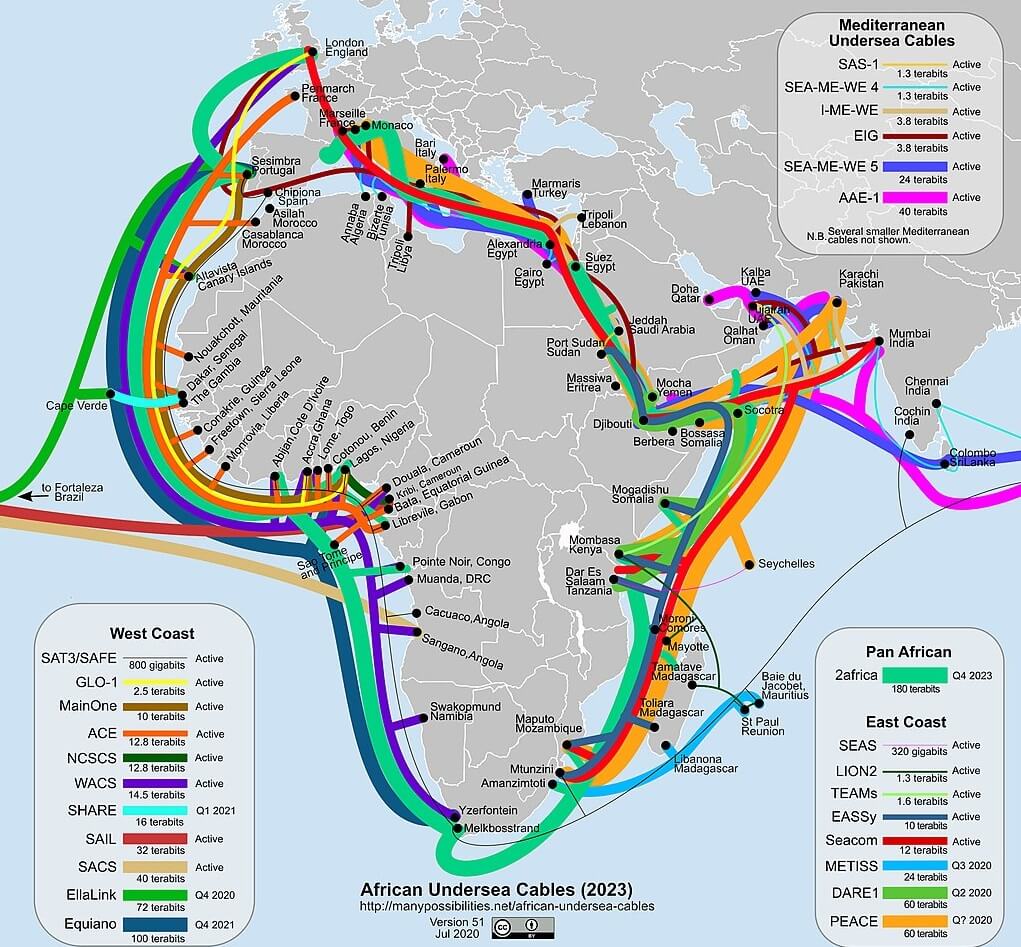Beyond the Red Sea blues: West Africa faces new cable outages.
As if three cable ruptures in the Red Sea were not enough of a headache, a series of West African cables were damaged on March 14.
The precise location and cause of all of these outages is not known at this time, but let’s look at what we do know.
Which cables are damaged?
According to reports from several network operators in the region, the following cables are damaged:
It is unclear at this time whether all four cables were damaged in the same event or if some had pre-existing defects. These cables join the previously damaged AAE-1, EIG and SEACOM/TGN-Eurasia systems in the Red Sea, which remain out of service.
Which countries are most impacted?
There is still no official information on the locations of the outages, for security reasons of course.
The Nigerian Communications Commission initially said the damage was somewhere between Senegal and Ivory Coast. Other reports have identified the location as being directly off the coast of Abidjan, Ivory Coast. At the end of the day on March 15, MainOne announced that their breakup was well off the coast of the Ivory Coast. The company says its first assessment of the cause of the outage is seismic activity, but will have more information once the cable is repaired.
CloudFlare has observed service outages in several countries starting south of Senegal, which may indicate damage to at least one cable somewhere off the coasts of Senegal and Gambia.
Assuming this is the possible demarcation point for damage, here is a list of West African coastal countries south of this line, the number of intercontinental cables connected to them and their status:
For West African countries that rely solely on one of the damaged cables, this does not mean they have lost access to intercontinental connectivity. They could send traffic undersea or overland to other countries that maintain intercontinental cable connectivity.
Systems still online include the new Equiano cable, as well as EASSy, Glo-1 and Maroc Telecom West Africa.
Let us also not forget that landlocked African countries like Botswana, Burkina Faso, Zambia and Zimbabwe also rely on these cables for their intercontinental connectivity and could also be affected.
How long will it take to repair these cables?
The time it takes to repair a cable depends on many factors, including:
Permits – maintenance vessels must obtain a permit from the government when repairs are required in their waters.
Loading: The repair vessel will need to go to a depot to load a replacement cable to accommodate the damaged cable.
Transit time: It takes time for a repair vessel to reach the area where damage is suspected.
Fault location: Locating the damaged part of the cable is not always easy because the location of a cable may have changed during the fault.
Repairing defects: The number of fibers and type of damage play a role in the repair time.
Weather window – before a repair begins, maintenance companies must assess whether weather conditions will remain suitable for a long enough period of time to complete the repair.
Repairs will certainly be quicker for these West African cables than for those in the Red Sea, where permitting issues and ongoing Houthi attacks point to long delays.
Although each repair situation is unique, we can consider the August 2023 repairs off the West African coast, near Angola and the Democratic Republic of Congo, as a guide. According to TeleGeography’s submarine cable rupture database, the number of days needed to repair these cables was as follows:
Note: Data shown is limited to what has been publicly disclosed.
What is the impact on consumers and businesses?
Network operators routinely route their traffic over multiple cables in the event of outages like this. A large number of cable outages reduces the amount of available capacity, which can degrade the quality of service. However, it is important to take into account the applications and services used. After all, not all user activity generates intercontinental traffic. Many services will continue to operate normally, locally.
At the time of writing, Amazon’s AWS cloud platform is not reporting any issues in South Africa, nor is Google Cloud. Microsoft has indicated that some users of its Azure cloud platform may experience increased latency and packet loss. The company said it is adding additional capacity and expects the issue to be resolved today, March 15.
Can satellites solve this problem?
Not really.
Submarine cables provide much more bandwidth than satellites. Satellites are certainly useful in ensuring that vital commercial and government services remain active if fiber optic connectivity is impaired or lost completely. However, satellites have limited capacity.
If you put together all the capacity of Starlink, Amazon Kuiper and other new satellite constellations, they would still be less than a tenth of the capacity of a single modern fiber optic submarine cable.



